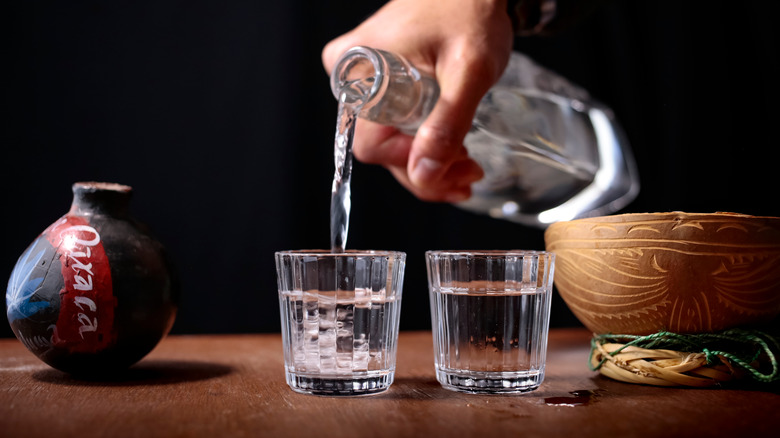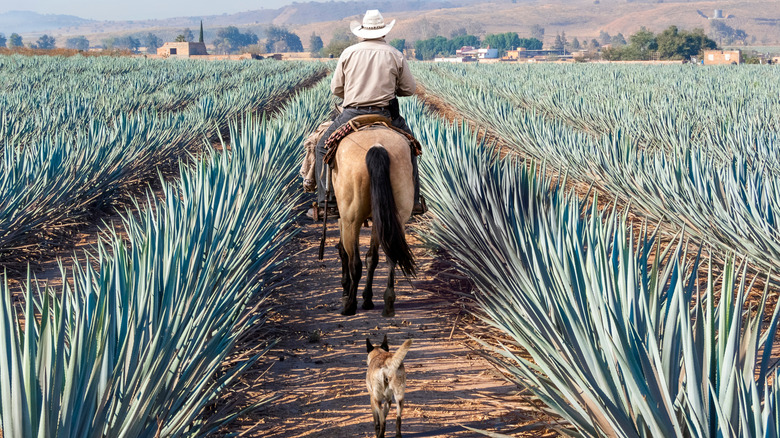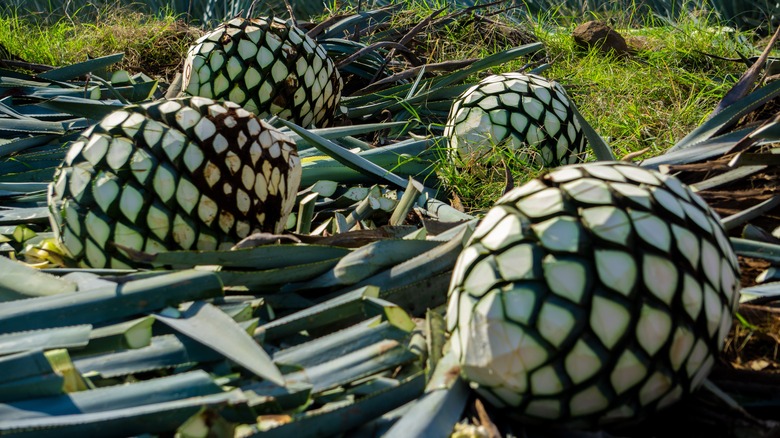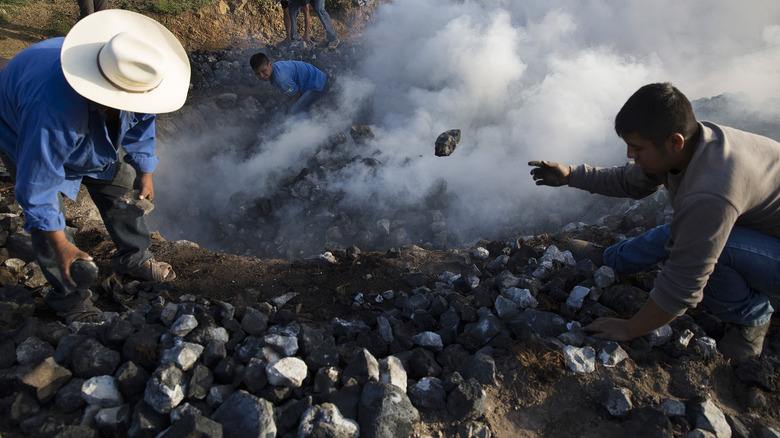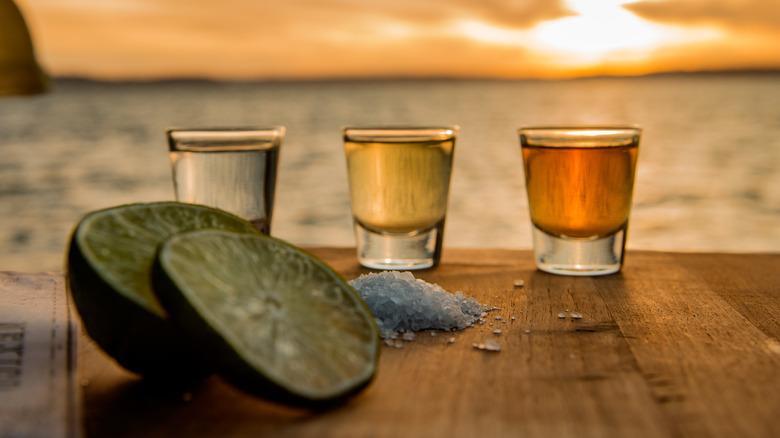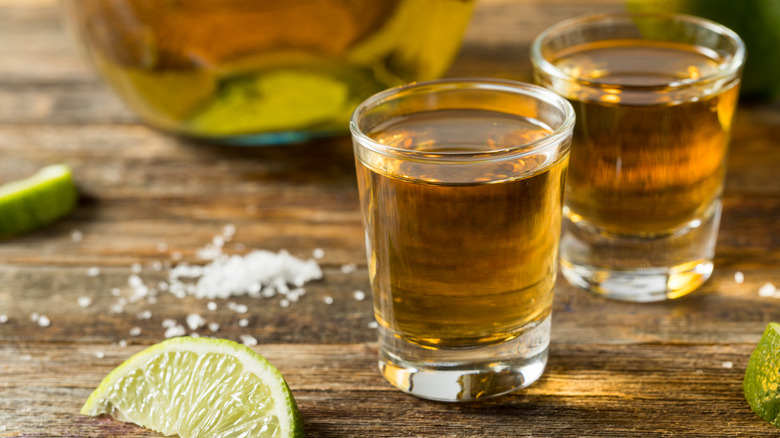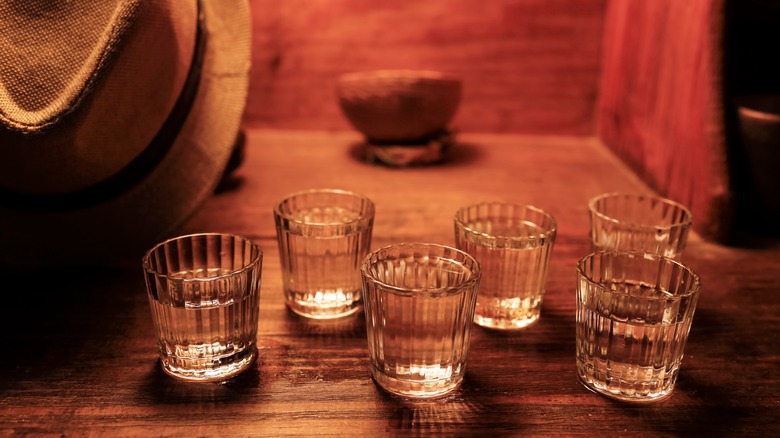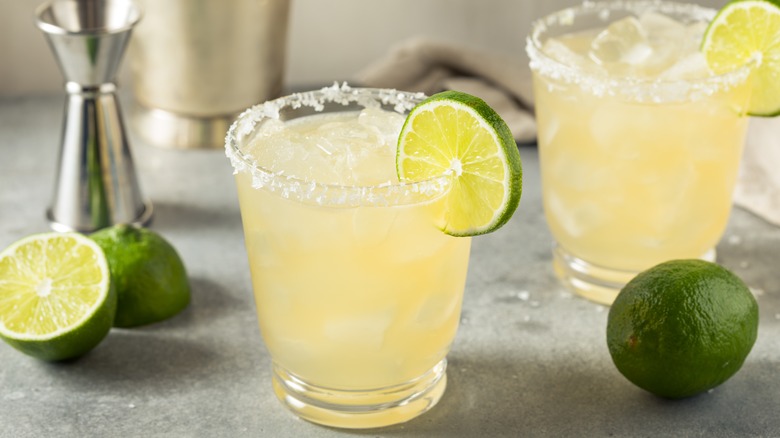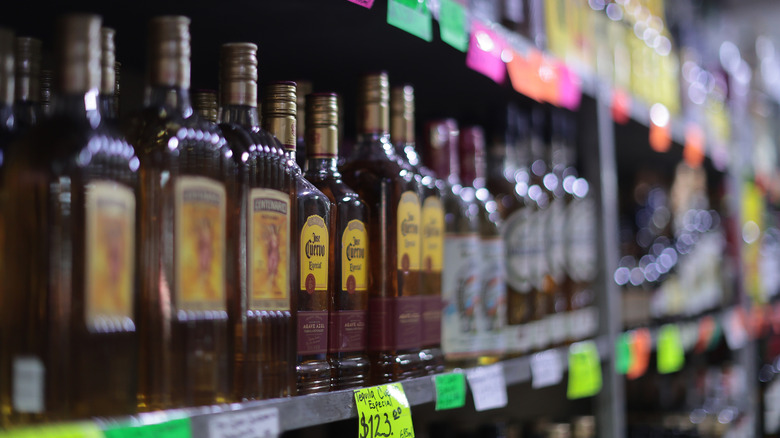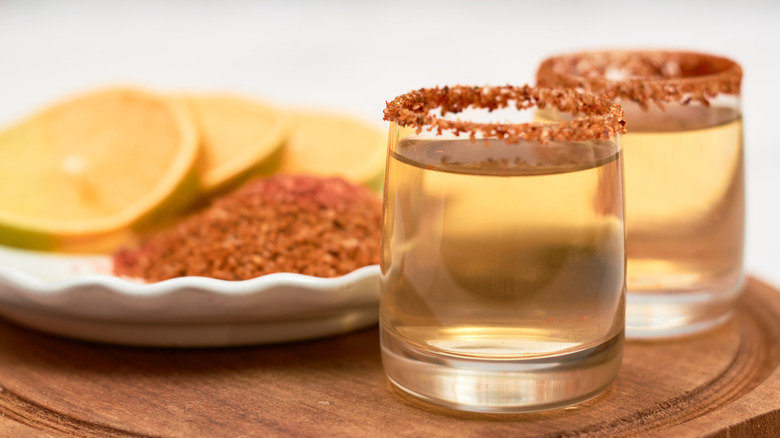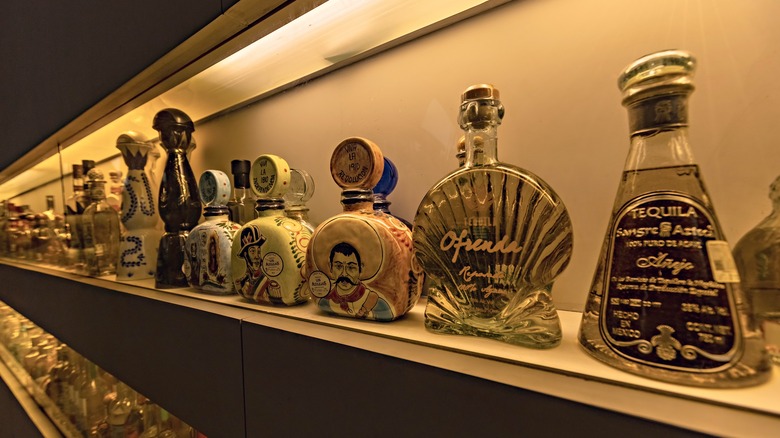What's The Difference Between Tequila And Mezcal?
Of all the liquors taking advantage of the current cocktail renaissance, few have done more than tequila and mezcal. In fact, according to Bloomberg, United States residents spent more money on tequila and mezcal in 2022 than they did on American-made whiskies such as bourbon or rye. However, this milestone is not likely to be part of a quick-passing fad, as the two are projected to combine to become the most purchased spirit by value at $13.3 billion in 2023, surpassing that of vodka at $12.5 billion.
Very few classic cocktails include tequila or mezcal, but both have contributed to instant modern classics that make each a must-have in any bar. The reality remains, however, that these spirits make excellent drinks because they are simply great spirits. The Mexican exports are prideful products of expert craftsmanship utilizing methods passed down through generations to create something special. Each is specific and unique to one area of the globe, unable to be replicated anywhere else.
Tequila and mezcal are both agave-based distilled spirits, and the two are often spoken about in the same breath, but what really is the difference between them? It turns out that these two spirits that share many similarities actually provide vastly different characters, come in their own unique styles, and have evolved from separate, very rich histories. Here is everything you need to know to distinguish tequila from mezcal and enjoy each of them to their fullest potential.
The history of tequila and mezcal
The origins of tequila can be traced all the way back to the third century, according to Tales of the Cocktail Foundation. The first form of the spirit was made by the Aztecs as a ceremonial wine called "pulque," which was made by fermenting juice pressed from agave plants. Pulque was an integral part of the life of the Aztecs, and they worshipped the two gods, Mayahuel and Quetzalcoatl, whom they related to alcohol.
The tequila we recognize today, however, did come to fruition until Spanish intervention. In the 1600s, Don Pedro Sánchez de Tagle, the Marquis de Altamira, established the first large-scale distillery in what is now the town of Tequila in the state of Jalisco region (via Drinks Geek). In 1758, the Cuervo family began distilling and selling tequila commercially, the first to do so.
Mezcal's history belongs to a different Mexican city, Oaxaca. The species of agave that mezcal can be made from are native to the region, per Mezcal for Life. Oaxacans began distilling mezcal roughly 400 years ago when they combined their natural resources with the distilling techniques brought over by Spanish colonists. The discovery of mezcal grew to be so profound that Oaxacans believed that the spirit was born from a bolt of lightning that struck an agave plant, the result of which came to be referred to as the "elixir of the gods."
How is tequila made?
Both tequila and mezcal start with the agave plant. According to Difford's Guide, there are 166 agave species, but blue Weber agave is the only one legally allowed for tequila. It must also be produced within five designated states (via Difford's Guide). Once the agave reaches maturity, it is harvested by highly-skilled people called "jimadors," who slice off the leaves, leaving only the piña, or core.
The piñas are then placed inside an oven to be cooked, a process done to extract the sap inside and convert it into fermentable sugars. The cooking may take 24 to 48 hours before the piñas are left to cool completely, then shredded. Some distilleries continue to use an ancient-style mill called a tahona, which was traditionally pulled by mules but is often machine-driven today. The stone wheel runs over the agave and presses out all of the liquid. Other distilleries extract the juice mechanically.
The juice extracted from the cooked agave is now ready to be turned into alcohol. The fermentation process is done with yeast and lasts between one and four days. Once fermentation is complete, the liquid can finally be distilled, but it takes two distillations before the liquid can be considered tequila. A second distillation is what brings the alcohol content to at least 55%. The result of the second distillate is diluted to bring the proof down to the desired amount, and the tequila is packaged and shipped.
How is mezcal made?
Unlike tequila, mezcal can be made from any species of agave, per Mezcalistas. In fact, any alcohol made from the agave plant is technically mezcal. One way to put it is that all tequila is mezcal, but not all mezcals are tequila. The regulations surrounding mezcal are more geographical. For example, mezcal can legally only be made in designated Mexican states, according to the Denominacion de Origin, Oaxaca being the most common.
The agave harvest is done the same way as tequila, with jimadors removing the leaves and exposing the piña. The most important and fundamental difference occurs with how the piñas are cooked. Instead of an oven, the agave is cooked in an earthen pit. The pits are filled with wood which is lit aflame and covered by rocks to create a low-temperature oven that adds a smoky aspect to the finished spirit. The piñas are placed inside the pit on top of the stones and covered with leaves, dirt, and cloth to enclose the heat. This is the most traditional method for producing mezcal, but the agave can also be cooked inside a brick oven.
From there, the process is basically identical. The cooked agave is crushed to extract its juice, which is then fermented, distilled, diluted, and bottled. The difference in cooking method and species of agave may not seem too consequential, but they go a long way toward a distinctly different spirit with a unique flavor profile.
Different types of tequila and mezcal
Once distilled, barrel aging is another step that can turn tequila or mezcal into a more complex spirit with a greater depth of flavor and aroma. Unaged tequila is called "blanco" (sometimes labeled "white" or "silver"), while aged tequilas begin with reposado. The word "reposado" translates to "rested" and refers to aging in oak barrels, per Taster's Club. Reposado tequilas are matured for a minimum of two months and up to a full year. During this period, the tequila takes on a golden hue and flavor notes from the barrel and is transformed into a softer spirit.
Another form tequila can take is añejo tequila, which is essentially an enhanced version of reposado. These are barrel-aged between one and three years, resulting in an even more palatable and complex flavor. There are also extra añejos that are aged even longer, between seven and 10 years. These have even more depth in their character but can be more difficult to come by.
As for mezcal, the same maturation methods, lengths, and terms are also applicable. The only difference is that a mezcal that has just finished the production process and has not undergone any aging is often referred to as a "joven" mezcal, per Agave Experience. Reposado, añejo, and extra añejo mezcals all reflect the same complexity and roundedness as their tequila counterparts, just with that extra smokiness and more varied agave flavor.
What does tequila taste like?
No matter what style of tequila you are enjoying, there is no flavor more prominent than agave. The most straightforward type of tequila is, of course, blanco. A quality blanco tequila will taste crystal clear with a bright and naturally sweet agave flavor. This clarity does translate to a more pronounced alcoholic bite, as no other factor is in play to dull it down. However, this is easily rectified by enjoying it on the rocks, topped with soda, or just a small squeeze of lime.
Reposado tequila is where the agave flavor is accompanied and complemented by the flavors imparted by barrel aging. The oak barrels used for maturing tequila are often the same ones used to age American whiskeys, such as bourbon or rye. The woody flavor notes combine with slight caramel in a reposado tequila that still places the agave on a pedestal but brings some more depth and character to support it.
The same effect is brought to a whole new level with añejo and extra añejo tequilas. The more time spent inside the barrel, the more distinguished its flavors and aromas. These notes do not overpower the agave, however. Instead, the intense vanilla, oak, and spice work in harmony with the sweet agave to form a spirit so delectable you will find it requires nothing more than a glass to sip it from and some company to share it with.
What does mezcal taste like?
We know that the only agave used to make tequila is blue Weber. This makes the foundational flavor of the spirit pretty much universal. Still, the many different species of agave grown and harvested for mezcal make the spirit more unique to each brand and distiller. There are an estimated 30 species of agave that can be distilled to make mezcal, grown in certain Mexican states (via Mezcal Ph.D.). Some agave is sweeter, some more herbaceous, and some can be bumped up by the earthiness from the cooking process.
Due to the cooking method, the flavor of mezcal is also a reflection of the terrain in which it is cooked. Mezcal can very aptly be compared to wine in this sense. Every single factor plays a part. The species of agave and the soil it is grown from and cooked within contribute different flavors and aromas that vary based on geography as well as species.
It is mezcal's smoky flavor that remains its X-factor. The only other spirit that can be likened to the taste is an Islay scotch whisky. However, the smokiness in mezcal is combined with the agave flavor to make it its own thing. Mezcal is distinctly smoky and earthy but is still bright and sweet. Truthfully, the only way to understand mezcal is by trying it for yourself. Chances are it will be love at first sip.
The best way to drink tequila and mezcal
Tequila is often considered a cheap drink for college students who want to drink shots to the point of irresponsible inebriation. However, these two spirits deserve much more attentiveness and sophistication.
The best way to indulge in every flavor note and aroma of the tequila or mezcal you drink is to sip it neat from a glass that allows enough room for both the nose and mouth. These types of glassware include wine tumblers, brandy glasses, or Glencairn glasses. There are also copita glasses, which are specific to tequila and mezcal. These are tulip-shaped with long stems, resembling Champagne flutes. Any glassware that is able to concentrate the aromas of the tequila or mezcal for your nose to take in will only inform your tastebuds and make each sip taste better. It will also begin to teach you what to look for in the liquors and help develop your knowledge and personal taste.
If sipping spirits neat isn't really your thing, both tequila and mezcal contribute to countless delicious cocktails. Classics like the margarita and Paloma are obvious choices, but a simple swap of mezcal for tequila creates a whole new way to enjoy them. Modern classics like the Oaxacan Old-Fashioned utilize both spirits in tandem to form an excellent Old-Fashioned variation. Others include the division bell, an equal-parts cocktail, and the mezcal Negroni, one Negroni variation that exploded out of the modern cocktail boom.
Is tequila or mezcal more expensive?
Generally, mezcal is a more expensive spirit to buy than tequila, but the price of a bottle of tequila or mezcal is dependent on the style. The least costly is blanco, and the most expensive is extra añejo, with reposado and regular añejo falling within that range, respectively.
As is the case with any spirit, the price can be determined by the brand and not necessarily the quality of the product. There are plenty of budget-friendly, high-quality, and versatile tequilas of every style, as well as lower-quality bottles that are overpriced because of their label or brand name and rare bottles sought after by collectors that cost thousands. Finding a brand that is good at what they do and sells its products at a fair price is part of what makes discovering tequila exciting.
The same goes for mezcal, but the average bottle will cost you more than tequila. This is because the typical agave plants used for mezcal take a much longer time to grow than the blue Weber agave used for tequila. Additionally, the process of making mezcal is more labor intensive, given the subterranean cooking method. These two factors do combine for a more expensive spirit, but a quality bottle of mezcal should still only cost you less than $40. If you have yet to try mezcal and decide to do so, you'll find that it's such a tasty spirit you won't think twice about the few extra bucks.
Is tequila or mezcal healthier?
Of course, no alcoholic beverage should be considered healthy, but tequila and mezcal are among the more harmless spirits out there. For example, tequila is a great alcohol option for those who are looking to cut down on sugar and calorie intake, according to Advanced Mixology. Also, tequila has low levels of methanol compared to other distilled spirits, meaning it may contain fewer impurities. A good way to ensure that you are reaping the benefits of the tequila you drink is to look for labels that include "100% agave" or any variation of that phrase. Tequilas that contain additives correlate to more sugar, which should be avoided if you are minding your health while enjoying a drink or two.
Mezcal is an even better health-conscious alcohol, according to Forbes. Mezcal is a more pure, "trustworthy" spirit, according to Dr. Taryn Forelli, because of the regulations surrounding it that exclude the use of any ingredient other than agave. As mentioned, some tequilas are 100% agave, but the fermentation difference between mezcal and tequila makes mezcal the healthier option. The agave plant contains a prebiotic property called "agavin," which kickstarts the fermentation process and, as researchers believe, can help regulate blood sugars and support the microbiome. This prebiotic is not found in tequila because tequila fermentation is not done using the entire agave heart, whereas mezcal is. Therefore, while both are definitely preferred spirits, mezcal one ups tequila in the healthy department.
The best bottles of tequila and mezcal
If you are unfamiliar with or want to dive deeper into the amazing and vast world of agave spirits, looking through the shelves at your local liquor store and seeing the dozens of labels can be overwhelming. So, here are a few bottles you can keep an eye out for to help you get started. You will notice the absence of celebrity-owned and marketing tequilas. These bottles may have some status of fame, but too often, they contain flavor additives and are rarely natural spirits.
El Jimador can take care of your tequila needs in both the blanco and reposado departments. This brand makes only 100% agave tequila, and a bottle of either style will only cost you around $20 (via Wine-Searcher). Another quality, affordable, and versatile tequila brand is Espolòn, which you can get a bottle of for less than $30 (via Wine-Searcher). If you want to get into the añejo game, Herradura makes a great añejo tequila that is perfect for sipping straight as well as in an Old-Fashioned. A bottle costs about $50 on average (via Wine-Searcher).
Reliable and simple mezcals that serve as an introduction to the spirit and the great cocktails that can be made with them are Del Maguey Mezcal Vida and Montelobos Espadin. Both are artisanal mezcals, meaning they are produced sustainably in small batches using completely organic ingredients and traditional methods. Plus, each only costs around $40 (via Wine-Searcher).
